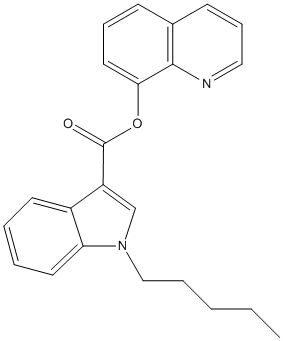Cannabinoid-PB-22
General
Type : Quinoline || Indole || Cannabinoid-Receptor-ligand
Chemical_Nomenclature : Quinolin-8-yl 1-pentyl-1H-indole-3-carboxylate
Canonical SMILES : CCCCCN1C=C(C2=CC=CC=C21)C(=O)OC3=CC=CC4=C3N=CC=C4
InChI : InChI=1S\/C23H22N2O2\/c1-2-3-6-15-25-16-19(18-11-4-5-12-20(18)25)23(26)27-21-13-7-9-17-10-8-14-24-22(17)21\/h4-5,7-14,16H,2-3,6,15H2,1H3
InChIKey : ZAVGICCEAOUWFM-UHFFFAOYSA-N
Other name(s) : PB-22, QUPIC, 1-Pentyl-1H-indole-3-carboxylic acid 8-quinolinyl ester

Target
Families : Carb_B_Chordata
References (3)
| Title : Pharmacokinetic Approach to Combat the Synthetic Cannabinoid PB-22 - Lin_2021_ACS.Chem.Neurosci__ |
| Author(s) : Lin M , Ellis B , Eubanks LM , Janda KD |
| Ref : ACS Chem Neurosci , : , 2021 |
| Abstract : Lin_2021_ACS.Chem.Neurosci__ |
| ESTHER : Lin_2021_ACS.Chem.Neurosci__ |
| PubMedSearch : Lin_2021_ACS.Chem.Neurosci__ |
| PubMedID: 34254505 |
| Title : Metabolic Profile of Synthetic Cannabinoids 5F-PB-22, PB-22, XLR-11 and UR-144 by Cunninghamella elegans - Watanabe_2017_AAPS.J_19_1148 |
| Author(s) : Watanabe S , Kuzhiumparambil U , Nguyen MA , Cameron J , Fu S |
| Ref : AAPS J , 19 :1148 , 2017 |
| Abstract : Watanabe_2017_AAPS.J_19_1148 |
| ESTHER : Watanabe_2017_AAPS.J_19_1148 |
| PubMedSearch : Watanabe_2017_AAPS.J_19_1148 |
| PubMedID: 28455676 |
| Title : Synthetic cannabimimetic agents metabolized by carboxylesterases - Thomsen_2015_Drug.Test.Anal_7_565 |
| Author(s) : Thomsen R , Nielsen LM , Holm NB , Rasmussen HB , Linnet K |
| Ref : Drug Test Anal , 7 :565 , 2015 |
| Abstract : Thomsen_2015_Drug.Test.Anal_7_565 |
| ESTHER : Thomsen_2015_Drug.Test.Anal_7_565 |
| PubMedSearch : Thomsen_2015_Drug.Test.Anal_7_565 |
| PubMedID: 25346527 |